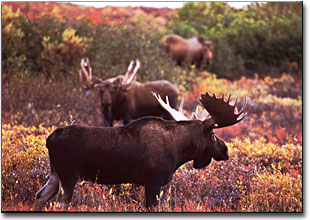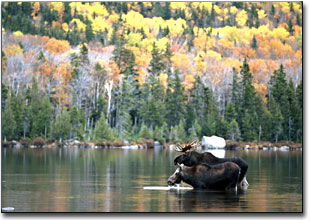|
The Camera Hunter®
Photography and Text Copyright Bill Silliker, Jr.
All rights reserved.

Camera hunting for a bull moose during the moose mating season presents a greater challenge than does shooting one with a firearm. Now I'll just bet that some folks doubt that!
Before we examine why, let me just add that one thing is easier for the camera hunter: he or she doesn't need a skidder or a come-along to bring home the prize. That roll of film in the pocket weighs a matter of ounces. It's only the telephoto lenses, camera bodies and tripod that weigh down the camera hunter.
The Reasons Why
So why is it more difficult to photographically shoot a bull moose in the fall? First, because the camera hunter needs a moose that's willing to pose for the lens. While you'll generally see a number moose if you cruise the big woods long enough or go to the right places and are patient, the bull moose that stands around and poses just isn't that easy to come by once the color hits the maple leaves. Most bull moose have only one thing on their minds from mid-September through late October: finding a willing cow moose. And so it's not easy to get into decent camera range on mature bulls when they're at their most photogenic.
There's also the question of light for the camera hunter. What good is a great moose when the light's all wrong? While the firearms hunter can drop a bull with a well placed shot, the best aim of the camera hunter camera does little good when the light is wrong. A camera hunter needs to catch his trophy in good enough light to properly record the dark animal on film. Properly balancing the brightness of the moose's rack against the dark coat also requires either a lower sun angle or the softer light of a light overcast sky. And for a real trophy a camera hunter needs to capture a glint in the moose's eye and get it "tack sharp".
Some Film Concerns
It's worth noting that those who hope to see publication of one of their trophy shots should be thinking about capturing them on high quality slide film. That's because most publishers require fine grained slide film for publication. While there are many film choices available today, I shoot the ISO 100 Fuji professional slide film products exclusively, and have for years. I like the natural look to the nature colors that these films provide. While I am sponsored by FujiFilm Professional to do slide talks and in my workshops with L.L. Bean, my allegiance to these films was a photography decision alone, made long before any offers of sponsorship came along.
Now that the new Fuji Provia 100F is available, I use it for most of my shooting. It can easily be "pushed" a stop, or even two, to save an opportunity in low light. Pushing film takes it past its rated capability, and requires that you tell the lab to process it "pushed" for the exposure index you shot it at. In the case of Fuji films, it's a straight doubling of the rated ISO. I shoot Astia or Provia 100F, both normally rated at ISO 100, as if they had a film speed of ISO 200. Then I tell the lab to "push one stop to get the results I want. While the grain might increase a tad and the contrast will enhance, it's the best way to save the day for a great moose pose in low light.
The Safety Factor
It's also not as safe to hunt a moose with a camera as it is with a firearm. Remember that the firearms hunter is armed. The camera hunter is not. Anyone who doubts that an angry moose can kill you should contemplate recent history in Alaska. Two people have been killed there by attacking moose in the past several years, both in urban areas. One fatality was videotaped: the attacker was a cow moose defending its calf of the year from thoughtless students at the University of Alaska who had been harassing it with snowballs. Another moose nailed a woman in her own backyard in Anchorage when she apparently tried to break up a dispute between the moose and her dog. The wardens never saw the animal, but evidence clearly indicated that she was stomped to death by a moose.

A bull moose that will tolerate no competition in his kingdom casts at least a dirty look and sometimes even a head toss of his handsome rack at anything suspicious that he hears but can't quite make out. Moose actually don't see very well, but they sure can hear you coming. If you're downwind or there's little wind to tip him off he may well wonder if what he hears is another moose. While that can work to the camera hunter's advantage, you'd better pay attention to his body language in case he gets really worked up. I've been backed off by a few bulls who made it quite clear that they were in charge of their stretch of woods and that they wouldn't tolerate with any interference.
Talking to the big guy sometimes helps in these situation. Having a sturdy tree real handy to climb or at least to get behind helps a lot too! Consider the size, strength and speed of bull moose and the fact that they really do have poor vision before you laugh too hard at the notion of talking to one to calm him down. Talking to him lets him know that you are a human. It's insurance, just in case he didn't make you out as one.
What does one say to a bull moose? It depends on the day and the moose. I've told them that they looked pretty good, but could they turn sideways to get into better light or maybe show me the best side of their rack. Mostly they ignore such comments. I've also told one big bull that the honey he was challenging me over was all his, that she was beautiful, but that he had found her first and that he needn't worry about competition from me. That seemed to work. He stopped waving his lowered rack that he was showing off from 50 feet away and he didn't come any closer.
Talk to the big guy? Sure thing. You doubters can laugh about it, but only after you've tried it first.
Catch yours in the good light.
BS-NPN
Maine wildlife & nature photographer Bill Silliker, Jr. – The Mooseman - photographed at many wild places in North America, with the results published in magazines internationally and in 9 of his own books. Bill was an instructor of wildlife and nature photography for L. L. Bean's Outdoor Discovery Program and a member of the Fuji Film Talent Team. Read more about Bill on the Camera Hunter archives page.


| 


